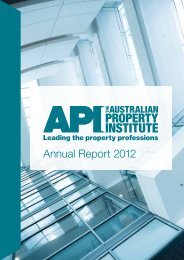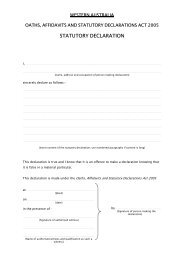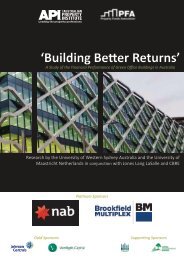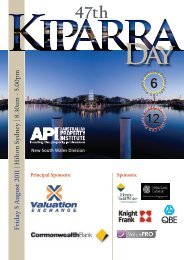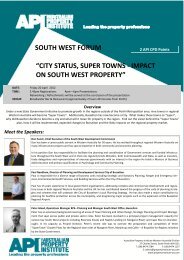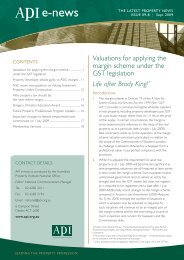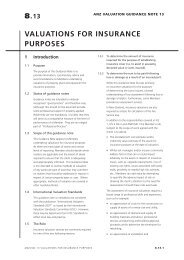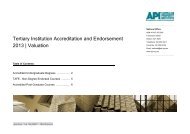ANZPJ Sep 2012 - The Australian Property Institute
ANZPJ Sep 2012 - The Australian Property Institute
ANZPJ Sep 2012 - The Australian Property Institute
- No tags were found...
Create successful ePaper yourself
Turn your PDF publications into a flip-book with our unique Google optimized e-Paper software.
CARBON TAXWILL A CARBON PRICECHANGE PRIVATE FARMFORESTRY IN AUSTRALIA?510 <strong>ANZPJ</strong> SEPTEMBER <strong>2012</strong>
CARBON TAXRural industries will be affected by the Federal Governmentcarbon price, with impacts on input costs. Ian Clarkson FAPI,lecturer in property at Central Queensland UniversityFaculty of Arts, Business, Informatics and Education, examineswhat the carbon tax could mean for farm forestry.511
CARBON TAXDuring the interimbefore the EmissionsTrading Scheme (ETS) isintroduced, farms havean opportunity to eitherearn money through selling carboncredits or at least reduce the impactan ETS will have on their ongoingfarming costs when it is introduced ifthe framework for separating carbonrights to allow sale is completed.John Sheehan (2009) noted that theKevin Rudd-proposed carbon pollutionreduction scheme (CPRS) did notclearly differentiate between propertyrights and carbon rights and how thesemay be exchanged.A number of states have adoptedprofit-à-prendre as a basis for theright to carbon. This enables a personto take part of the soil or produce ofland that someone else owns. It is aright to take from the land, as in themining of minerals, but in this casemeans carbon credits. However, thisaction offends the common law notionof land property and is fundamentallyflawed (Sheehan, 2009). This raises thepoint as to how carbon rights may betransferred or paid for in the contextof separating the carbon right from theland right.Whilst energy, through powergeneration and the transport of goods,is the biggest producer of greenhousegases in Australia, the second highestproducer of greenhouse gases isrural industries. Garnaut cites thatagricultural emissions are more than sixtimes the Organisation for EconomicCooperation and Development (OECD)average, being the third highest.In Australia, agriculture directlycontributes around 15% of the country’sgreenhouse gas emissions (Meer, 2009).This is balanced slightly as Australiahas the most wooded area of any OECDcountry with about 28.8 hectares perperson (Garnaut, 2011). However,agricultural greenhouse gas emissionsfell by 0.6% in the 2011 financial yearfrom the previous year’s output.BREAKDOWN OF AGRICULTURAL EMISSIONS65%1%13%4%17%FIGURE 1 AUSTRALIA AGRICULTURE EMISSIONS (MEER, 2009)To reduce greenhouse gasemissions in Australia further, Garnautrecommends an almost 30% reductionof the <strong>Australian</strong> cattle herd down to 18million, with a 40% reduction in sheepto 45 million head based on the redmeat consumption of Australia and thereplacement of high methane producerswith ‘greener’ chicken and kangaroo.However, sheep are not just used formeat consumption, with the majority(around 67%) used for wool production.This natural product would need to bereplaced by alternative fibres if flockreduction occurred, and there appearsminimal accounting for this in the report.Another argument has beenadvanced that the use of wool willdiminish as more synthetic fibres areproduced, but synthesised polymers aregenerally produced from petroleumbasedchemicals and account for aroundhalf of the world’s current fibre use.Textile production is the fifth largestcontributor to carbon dioxide emissionsin the United States (EIA, 1998). <strong>The</strong>Stockholm Environment <strong>Institute</strong>also shows that due to the high energyrequirement of extracting oil fromunderground, there is around 9.52 kgs ofcarbon emissions per tonne of spun fibreAgriculture’s GHG emissions by source65% Enteric Fermentation4%Manure Management0%Rice Cultivation17% Agricultural Soils13% Prescribed Burning of Savannas1% Field Burning of Agricultural residuesTotal Agricultural emissions = 88 million tonnes 2007in creating polyester in the US, comparedto 5.89 kgs of carbon dioxide to produce1 tonne of cotton in the US (SEI, 2005).CARBON CREDITS IN THERURAL INDUSTRY<strong>The</strong>re has been no possiblecommencement date announced fora trading scheme at the time of thepreparation of this paper by the Gillardgovernment, just the introduction ofthe carbon price from 1 July, <strong>2012</strong>.Peter O’Brien, Managing Director ofRural Industries Research DevelopmentCorporation, said: “Agriculture willbe affected by the CPRS both directlyand indirectly. Emissions costs in theform of abatement and/or to purchasepermits will potentially account for asignificant share of production costsfor livestock sectors and it is difficultfor <strong>Australian</strong> farmers to pass thecosts to their customers because mostof their products are exported. Even ifagriculture is not included in a CPRS,it will still be impacted by higher inputprices and lower demand.”<strong>The</strong> three options presented for areduction of agricultural greenhousegases are changing the <strong>Australian</strong> meat512 <strong>ANZPJ</strong> SEPTEMBER <strong>2012</strong>
CARBON TAXherds away from methane-producinganimals to non-ruminant indigenoussources such as kangaroo; reducingthe size of farm operations whilstmaintaining the farm size, such aslowering stock rates and less intensivecropping; and creating a form of‘carbon sink’ by either re-forestation oranother source of bio-fixing of carbonsuch as in-soil sequestration.A sectoral analysis using agriculturalcommodity models suggests thatsectoral output would fall by from halfa percentage point to over 4% when thepermit price is $25 per CO2 equivalent.This estimate of downturn would meanthat a carbon price of $25 per tonnecarbon dioxide has the potential to closeup to 14% of beef producers, being thesmaller farms in the sector (Jiang, 2009).<strong>The</strong> most progressed thinkingto try to offset some of the carbonissues is the re-forestation of degradedland – land close to waterways orstrategic land which will form shade orwindbreaks for more efficient overallfarm production. However, currentlythe harvesting of trees or their lossin a natural disaster such as bushfirewould be treated as an emission underthe Kyoto Protocol. As a result of thisthe owner of the forest would have tosurrender the credits unless the treesare replanted immediately after anevent as the CPRS has a requirementfor tree plantations to be maintainedfor 100 years.Carbon Neutral reports on its website:“We currently plant an averageof six to seven trees per tonne. In the350-450 mm rainfall area of WA,we estimate the number of treesrequired per tonne of CO2 varies fromfour to 10 depending on location,species of tree, soil type and type ofplanting. If we could plant karri treesin 1,000 mm rainfall areas, it could bemore than a tonne of CO2 per tree!”(Wilson, 2010)<strong>The</strong> <strong>Australian</strong> GreenhouseOffice (AGO) has also developed awebsite where information can be putin to calculate how much carbon issequestered by a hectare of forest. <strong>The</strong>approximate average allowed within an<strong>Australian</strong> context is around 600 to 650tonnes of carbon per hectare during a25- to 30-year growing cycle for most<strong>Australian</strong> hardwood species.<strong>The</strong> AGO has calculated a 30 tonneper annum figure for the scenariodeveloped by Private Forestry SouthernQueensland, which was a trial plot oftimber near Kenilworth. <strong>The</strong> initial datawas entered prior to planting and is beingupdated as the trees grow. However,20 tonne was used in calculations as aconservative benchmark.IT IS THE EXTENT TO WHICH RURALINDUSTRIES AND HIGH EMITTING INDUSTRIESARE CAPTURED WITHIN ANY CPRS WHICH WILLINEVITABLY CREATE THE PRICE FOR CARBONAND THE AMOUNT THAT PEOPLE ARE WILLINGTO PAY TO AVOID THE COSTSoil carbon sequestration is alsopotentially a very large pool, with aglobal estimate of 2.3 trillion tonnesof available matter, three times that ofcarbon in the atmosphere. This pool ofcarbon storage or sequestration is thatcontained in soil microbes, worms etc;labile carbon of decaying plant matter;and fixed carbon in stable compounds.This is separate to the sequestrationin forestry timber and subterraneanburial, which was proposed for somepower stations with the capture at thetop of the stack and then pumping downto great depths in the earth stratum.However, a big hurdle to adoptingthese practices is how to measure andAre you managing, selling, leasing or subleasing commercial ofce space?<strong>The</strong> Commercial Building Disclosure Program mandates the disclosure of energy ef ciency in large commercial of ce spaces.<strong>The</strong> Building Energy Ef ciency Disclosure Act 2010 requires that before sale, lease or sublease, most commercial of ce buildings with a net lettable area of 2000m² or more, need todisclose an up-to-date energy ef ciency rating in a Building Energy Ef ciency Certi cate (BEEC).BEECs are valid for up to 12 months, must be publicly accessible on the online Building Energy Ef ciency Register, and include:• a NABERS Energy star rating for the building• an assessment of tenancy lighting in the area of the building that is being sold or leased and• general energy ef ciency guidance.<strong>The</strong> NABERS Energy star rating must also be included in any advertisement for the sale, lease or sublease of the of ce space.<strong>The</strong> Commercial Building Disclosure Program creates a well informed property market and stimulates demand and investment in energy ef cient buildings.For more information about the Commercial Building Disclosure Program visit www.cbd.gov.au or email info@cbd.gov.au.AG65703
CARBON TAXINDUSTRYRETURN ON INVESTMENT(inc. capital growth allowances)RETURN ON INVESTMENT(ex. capital growth allowances)Beef cattle -1.3% to 2.5% -1.5% to 1.7%Dairy production -3.2% to 6.2% -3.9% to 4.1%Grain production 2.1% to 3.5% 1.0% to 1.9%Lamb/sheep production 3.7% to 4.2% 0.2% to 2.1%Private farm forestry calculation(excluding carbon income)3.46% to 4.56% 1.5% to 2.1%Private farm forestry calculation(including carbon income)4.31% to 5.64% 2.2% to 3.5%Source: ABARE 2009 & auther 2011verify the carbon sequestered/abatedin a quick, reliable and cost-effectiveway. Directly measuring every farm’ssequestration is most accurate butnot financially feasible. An indirectpractice-based model, combined withsoil sampling, carbon modelling andrandom verification, however, seemslike a viable option (Jiang, 2009).THE RETURN ON PRIVATE FARMFOREST INTEGRATED INTO A FARM<strong>The</strong> scenario is based upon the SouthEast Queensland sub-tropical wetsclerophyll zone. <strong>The</strong> amount of carbonwhich will potentially be sequestered isassessed via the AGO modelling toolwebsite, with the study based upon amixed Eucalyptus cloeziana (GympieMessmate), Eucalyptus punctata (GreyGum) and Corymbia maculata (SpottedGum) native hardwood forest.Data was entered into the tool box,along with rainfall, soil informationand management regime by Sean Ryanof Private Forestry Service Queensland.<strong>The</strong> prediction accounts for the totalcarbon sequestered within the trees,soil and debris. It is expected that thecurrent 100% discount for harvestedmaterial will change in the foreseeablefuture and will allow for carbon storedas either a sawn product or power pole,etc (Ryan, 2010).Based upon average growth ratesand a carbon price of $23 per tonne,the farm income shows a return oninvestment (ROI) of 4.56% for theforest. This return includes a landfigure at the current price for accuracyin return analysis. It should be notedthat only half of carbon credit needs aresourced from Australia. New Zealandhas seen many credits purchased offshore in Mali and similar locations. Alower price for credits would decreasethe return by around 1%.THE MOST PROGRESSED THINKING TO TRY ANDOFFSET SOME OF THE CARBON ISSUES IS THERE-FORESTATION OF DEGRADED LAND.<strong>The</strong> data was also run for a variationin the analysis accounting for slowergrowth rates, with a slower growthrate changing the original return tothe farm from 4.56% down to 3.46%and pricing for quality also impactingon results.<strong>The</strong> 2007 to 2009 ABARE data(ABARE, 2011) has been summarisedfrom its <strong>Australian</strong> farm surveys 2010industry series in figure 1 (page 512).<strong>The</strong> table above comprisesa comparison of rural industryfarm returns (ABARE 2009 andauthor 2011).Whilst there has been a push topursue the ‘carbon neutral farm’, it isworth noting that Andrew Duffy, asheep grazier and winner of the 2009Raising the Baa competition and whohas planted forest on around 17% ofhis property with Melville Forest, wasquoted in an article as saying, “Basedon present production estimates,Melville Forest emits some 2,250tonne of CO2 equivalents per year.To offset this [it] would take 580 haof plantations or 40% of the property(Cuming, 2009).CONCLUSIONWhile legislation was passed inFederal parliament in late 2011 fora carbon price of $23 per tonne,the full ETS or other trading schemeis yet to be enacted. <strong>The</strong> mostknowledge we have is of re-forestation,so it will be the primary way forcredits to be purchased; for example,the option of offsetting a Qantasflight with the company purchasingtrees for planting. An economicand accurate measurement ofcarbon sequestration projectionsof stable carbon humates deeperthan 100mm is yet to be completedand internationally recognised socurrently re-forestation will progressas the primary option for offsettingcarbon emissions.514 <strong>ANZPJ</strong> SEPTEMBER <strong>2012</strong>
CARBON TAXIt is the extent to which ruralindustries and high-emitting industriesare captured within any CPRS whichwill inevitably create the price forcarbon and the amount that people arewilling to pay to avoid the cost.Plantations established since 1990and re-forestation will certainly bepart of a long-term strategy for ruralproducers to offset the cost of carbonemissions from their properties,depending upon what is captured in thelegislation and how soon.<strong>The</strong> full paper for this article can beviewed at http://www.prres.net/papers/Clarkson_Will_a_Carbon_Price.pdf.Information has been sourced fromgovernment bodies, industry interestgroups and interviews with peakbody representatives. •REFERENCES• ABARE 2011. <strong>Australian</strong> Commodities Outlook2011. In: WRIGHT, A. (ed.). <strong>Australian</strong> Bureau ofAgriculture and Resource Economics and Sciences.• CUMING, M. 2009. Carbon neutral farminga furphy [Online]. Unley, South Australia.Available: http://sj.farmonline.com.au/news/nationalrural/agribusiness-and-general/general/carbon-neutral-farming-a-furphy/1466974.aspx[Accessed 18/07/<strong>2012</strong> <strong>2012</strong>].• EIA. 1998. Changes in Energy Intensity inthe Manufacturing Sector 1985-1994 [Online].Washington D.C.: U.S. Energy InformationAdministration. Available: http://www.eia.gov/emeu/mecs/mecs94/ei/ei_2.html [Accessed 2011].• GARNAUT, R. 2011. Garnaut Review2011. Canberra.• JIANG, T., HANSLOW, K. AND PEARCE, D2009. On farm impacts of an <strong>Australian</strong> ETS -Economic Analysis. Canberra: Rural IndustriesResearch and Development Corporation.• MEER, C. 2009. Agriculture & the CPRS.Canberra: Department of Climate Change.• RYAN, S. 2010. RE: <strong>Australian</strong> Greenhouse OfficeData. Type to CLARKSON, I.• SEI. 2005. Ecological Footprint and WaterAnalysis of Cotton, Hemp & Polyester [Online].Stockholm: Stockholm Environment <strong>Institute</strong>.Available: http://www.sei-international.org/publications?pid=1694 [Accessed 2011].• SHEEHAN, J. 2009. Carbon and rural property.<strong>Australian</strong> <strong>Property</strong> <strong>Institute</strong> Victorian DivisionAnnual Conference <strong>Australian</strong> <strong>Property</strong> <strong>Institute</strong>Victorian Division.• WILSON, R. R., I AND OTHERS. 2010.Carbon Neutral [Online]. Carbon Neutral.Available: http://www.carbonneutral.com.au/[Accessed 20/08/2010].IAN CLARKSON FAPI IS ALECTURER IN PROPERTY ATCENTRAL QUEENSLAND UNIVERSITYFACULTY OF ARTS, BUSINESS,INFORMATICS AND EDUCATION515



